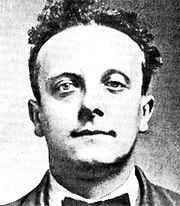Sidney Harry Fox

Sidney Harry Fox (died 8 April 1930) was a British petty swindler and murderer. He was executed for the murder of his mother in an attempt to obtain money from an insurance policy on her life. His case is unusual in that it is a rare example of a known matricide in the United Kingdom.
His murder was detected by then recent advances in forensic pathology.
Early life
Fox was described as "the son of decent working Norfolk parents";[1] little is known of his father, although it has been said that he was a railway porter. Fox was in trouble in his teens as a petty thief, and was birched for that.[1] He later developed a role as a plausible con-man, until World War I, when he obtained a job in a London bank and proceeded to forge cheques from his customers. On discovery of his dishonesty, Fox was offered immunity from prosecution on condition that he enlisted in the Army, however he enlisted in the Royal Air Force, claiming to be an Old Etonian.[1]
The murder
Fox and his mother Rosaline lived on 18 shillings per week (£43 equivalent in 2010) between them, supplementing this by cashing worthless cheques and moving from town to town. In 1927, Fox was imprisoned for fraud and his mother committed to the workhouse. On his release, he commenced an affair with a Mrs Morse despite his homosexuality;[2] he stole her jewellery and insured her life for £6000 (£284495 in 2010). Mrs Morse awoke one evening to find the gas-tap in her bedroom turned on. Fox was imprisoned for the jewellery theft and released in March 1929; he and his mother renewed their travelling life.
In April 1929 Fox persuaded his mother to make a will in his favour, despite her poverty, and on May 1, insured her life against accidental death, the policy to expire on 23 October. Some months later, they arrived at a hotel in Margate without any luggage and booked rooms. A week later, on 23 October, Fox and his mother ate dinner, Fox buying a half-bottle of port as a "nightcap" for her. At 11.40 pm that evening, Fox raised the alarm that there was a fire in his mother's room, and her partly clad body was pulled out of it by another guest.
Although a doctor certified suffocation and shock as the cause of death, and Rosaline Fox was buried in Norfolk a week later, the insurance investigators had examined the room and were suspicious. They believed that a patch of unburnt carpet between Mrs Fox's body and the gas stove supposedly the source of the flames made Fox's story inconsistent. As a result, Mrs Fox's body was exhumed for forensic examination.
Sir Bernard Spilsbury performed the post-mortem and deduced that Mrs Fox had been strangled to death, due to a bruise on her larynx, and the absence of soot in her lungs showed that she had been dead before the fire had started. As a result, Fox was arrested and charged with the murder.
Trial
Fox was tried at Lewes Assizes before Mr Justice Rowlett, with Sir Henry Curtis-Bennett and Sir William Jowitt (then the Attorney-General) prosecuting, and J. D. Cassels defending. The defence were unable to challenge the evidence given by Spilsbury since the bruise on Mrs Fox's larynx had disappeared due to decomposition by the time their experts had examined it. Jowitt subjected Fox to a ferocious cross-examination, and Fox's excuse that he had closed his mother's door "so that smoke should not spread into the hotel" appeared to be cowardly. The jury therefore convicted Fox and he was hanged at Maidstone Jail on 8 April 1930, the Home Secretary having declined to intervene.[3] Cassels later remarked that Fox might have saved himself by answering "I don't know" to Jowitt's question "why did you shut the door?"
Dramatisations
Around 1948, the radio series "Secrets of Scotland Yard" dramatised the story under the title "Smoke Clings to the Hair".
The case was dramatised as "Murder at The Metropole" in 1976 as part of the "Killers" television series; Fox was played by Christopher Timothy.[4]
A later (1981) version, produced by Granada Television under the title "Lady Killers: A Boy's Best Friend", starred Tim Brierley.[5]
References
- ↑ 1.0 1.1 1.2 "Papers Past — Evening Post — 19 May 1930 — CAREER OF CRIME". paperspast.natlib.govt.nz. Retrieved 2010-10-18.
- ↑ (Wilson 1984, p. 248)
- ↑ "Papers Past — Evening Post — 7 Paengawhāwhā 1930 — MARGATE MATRICIDE". paperspast.natlib.govt.nz. Retrieved 2010-10-17.
- ↑ ""Killers" Murder at the Metropole (TV episode 1976) - IMDb". www.imdb.com. Retrieved 2010-10-17.
- ↑ "BFI – A BOY'S BEST FRIEND (1981)". ftvdb.bfi.org.uk. Retrieved 2010-10-17.
Sources
- Wilson, Colin (1984). Encyclopedia of Murder. Pan Books. pp. 248–249. ISBN 330283006 Check
|isbn=value (help). - F. Tennyson Jesse, "Sidney Fox", in "Famous Trials III" (ed. James H. Hodge), Penguin Books, 1950, pp. 43–96
- David K. Frasier, Murder cases of the twentieth century: biographies and bibliographies of 280 convicted or accused killers, McFarland, 1996, ISBN 0-7864-0184-2, pp. 150–151
- Sir Sydney Smith, Mostly murder, D. McKay, 1959, p. 151